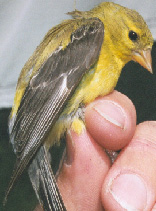- Order: Passeriformes
- Family: Fringillidae
- Genus: Carduelis
- species: tristis

This is a male American goldfinch

This is a female American goldfinch
TAXONOMY:
|
 This is a male American goldfinch |
 This is a female American goldfinch |
| FOOD: eats seeds, insects, and berries. MATING SYSTEM: monogamous. |
 |